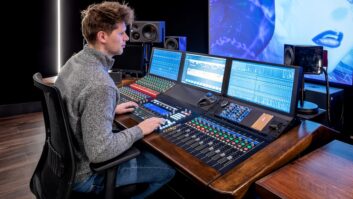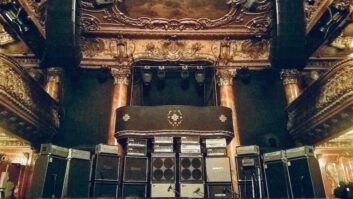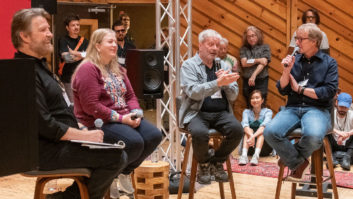
From left to right: Tinson Li (Manager IT Technology) Sherri Hendrickson (Director Broadcast Media and Operations), Stephen Colón (Manager Audio Production) in Control Room “G.”
Photo: Sherri Stacy Hendrickson
There are no Aeron chairs or hardwood floors at the newly revamped Frank Stanton Studios in downtown Los Angeles. These are radio studios, where all the rooms are small and dry, and the machine room is loaded with floor-to-ceiling racks of networking equipment. It’s where American Public Media supports local station Southern California Public Radio (SCPR) and produces the daily Marketplace series of business news and economic life programs, heard nationally on more than 500 public radio stations by almost 11 million listeners a week.
Putting out nine feeds of talk-oriented radio every day takes some serious choreography, and the workflow and studio needs have evolved a great deal since the program first started in 1989. They’re producing more shows, incorporating remote hosts and reporters headquartered in seven other bureaus around the world, and also recording material for radio stations in APM’s network of stations and creating online content.
So five years ago the company began an ambitious project to update all of its studios and make them more flexible—without disrupting the ongoing Marketplace shows. The main thrust of the upgrade was to incorporate IT with all the audio networked through the facility, but they also redesigned the rooms to address a variety of issues.
This is what the studio complex of the future looks like: Everything is IP multicast over the network. It’s what Sherri Hendrickson, APM’s Director of Broadcast and Media Operations, calls “digital 2.0.”
Sightlines
APM started by enlisting the Russ Berger Design Group to plan the control rooms, studios and edit suites in the Frank Stanton Studios. On this project, RBDG was responsible for ergonomics and sightlines, listening positions, and then acoustics—within the confines of a “sensible” budget. Staff designer Richard Shrag outlines the deceptively simple directive they were given: “Find the right balance of changes that are cost-effective, things that are easy or effective to change and will make a real difference.”
That mostly ruled out moving the walls of these curiously shaped rooms, with five and six sides, because this is a leased space. But they did strip the existing rooms down to their shells to start over. And they were able to update three spaces that are used for SCPR, the local APM radio station.
Because of the unusual room structures, sightlines proved difficult. Room layouts were rearranged to put the directors and hosts in a better position to communicate with one another. More than that, some hosts like to sit, some stand, but they all want to be where their voices sound best to them in the room. And the directors/engineers also needed to have eye contact.
Those considerations lead the decisions about where to place the furniture and equipment, the lighting, and finally the acoustics. “We’re trying to deal with short reflections from locally reflecting surfaces,” Shrag says. “Since there are some givens in small spaces like this—from the windows, floor, table, and things like that—we want to take care of the surfaces we have some control over.”
That meant fabric-covered absorption on the walls. It also meant covering up some unnecessary windows, which helped correct issues in the monitoring environment—such as one speaker being in front of glass, the other in front of a dead wall.

Production Suite “H” with AXIA control screen (top), David editor (bottom), ProTools (right).
Photo: Sherri Stacy Hendrickson
APM now has three control room/studio pairs, four production suites, one edit suite, and one control room with a big video screen in place of a control room. That’s used for “host on a rope”—remote hosts in different locations, connected by ISDN or Comrex Access over the Internet (IP).
IP Multicast
APM recycled a huge pile of cable pulled from their old “digital 1.0” setup. The AES switcher is gone, the Studer console with AES and TDIF outputs, most of the analog cable—it’s all been replaced with Cat-5 cable and networking equipment.
That’s the heart of the redesign: IP multicast. Hendrickson explains: “It’s part of the networking spec of the entire IT industry. We run 16-bit/48k audio throughout the facility with no audio loss, through over-the-counter IT hardware. So we have a large Cisco switch [with special settings and configurations]. It has redundancy—dual power supplies, it sends emails if there are any errors… The idea of IP multicast rather than point-to-point is that it’s only streaming once, and everybody can tune in to it so you’re not using nearly as much bandwidth.”
Every audio source in every studio is on the network, once it’s been digitized into an Axia audio networking system. People run Axia iPlay software on their computers, so anyone in the building can listen to the output of, say, Program 1 in Studio G.
“In Axia, you make a big table of sources, all labeled, and it knows which sources are in use,” Hendrickson continues. “So a mic in one studio won’t interrupt a live host in another one. If I pull up a microphone in one of our studios, it still has your typical dynamics, EQ and compression available, but I can route it anywhere in our facility.”
That mic—they use Shure KSM32s—typically runs through a Great River preamp, a Crane Song analog compressor, and then it’s digitized into the Axia system at a node point. The engineers do all the other processing with plug-ins in their play-to-air DAW, which will be Dalet later this year.
Workflow
David Brancaccio, host of the Marketplace Morning Report, is in the New York bureau. Kai Ryssdal hosts the Marketplace Midday Report in Los Angeles. The locations make no difference to the production process. Latency over those distances is too short to affect conversations because the IP lines are point-to-point; unlike television, there’s no video bouncing up to a satellite and back.
When a reporter files a story, he or she writes a script that an engineer uses to assemble the files inside a DAW. The files include a reading of the report, ambience, sound clips, etc., all filed to APM’s FTP server.
An engineer then assembles a rough mix, often on a laptop, and a producer listens to it (on Dalet) for approval. Next, the engineer takes it into a production suite for final mixing—all inside the DAW, listening on Genelec 8050B monitors. Some rooms have Mac Minis running Pro Tools systems available for more elaborate productions, but mostly they’re used as backup recorders.
A typical Marketplace show combines elements from many sources, some live, some recorded, local or remote. In addition to the live host, there might be a reporter coming in over ISDN or Comrex Access (an IP codec), a commenter in APM’s New York bureau, yet another in the Washington, D.C., bureau, and transition music.
The shows themselves are mixed live on one of the Axia boards; one element fades out, another is triggered and faded in—but the elements have all been pre-mixed. Transition music and some sound effects are kept in stereo for the Internet version of a show, but most local stations broadcast the show in mono.
Signature Sound
Marketplace is a fast-paced show, and the small, absorbent rooms contribute to its signature sound. So do the analog compressors; in fact, live reporters are often routed through them just for the sound.
As with almost all radio production, voices are usually close-miked. The mics in the studios—the Shure KSM32 is a large-diaphragm cardioid condenser—have double pop filters in front of them. Guests are generally directed to move up to the mics. Unlike a lot of network television, voices aren’t reflexively highpassed at around 120 Hz.
“Being a business report, being very short and to the point, the Marketplace sound uses some compression and limiting,” Hendrickson says. “We don’t do it as much as commercial radio does, for sure, but it isn’t quite the NPR kind of slower rolling, rhythmic sound.
“Our shows are very tight,” she concludes. “Our morning show is only 10 minutes long, our reports are a few minutes long, so it’s straight, punchy and direct.”
APM’s Frank Stanton Studios is an interesting facility, set up to address needs specific to the Marketplace and SCPR radio broadcasts. But the IP networking concept at the heart of their redesign applies to most commercial studios. Once audio is on a network, there’s no difference between sources in the same building and in the same planet.
That’s something to ponder next time you turn on the radio and hear those Korg M1 marimba rolls and Roland TR-808 timbales in the Marketplace theme music.
Nick Batzdorf works in journalism, audio and music, and produces reports for Marketplace and other public radio programs.







